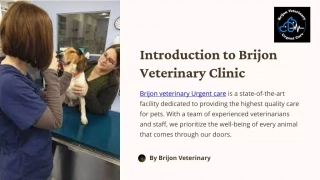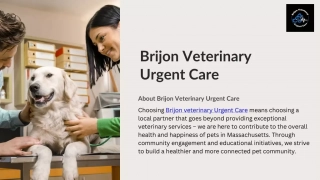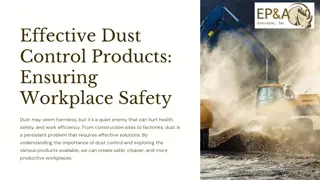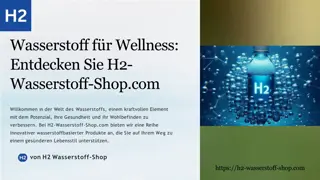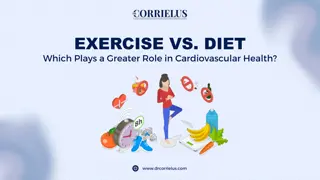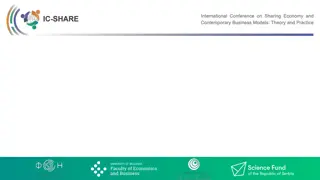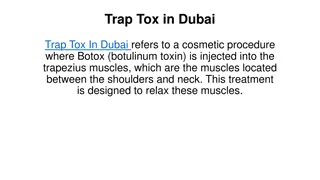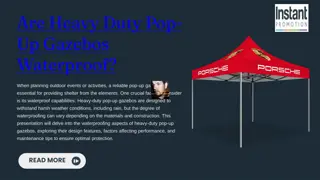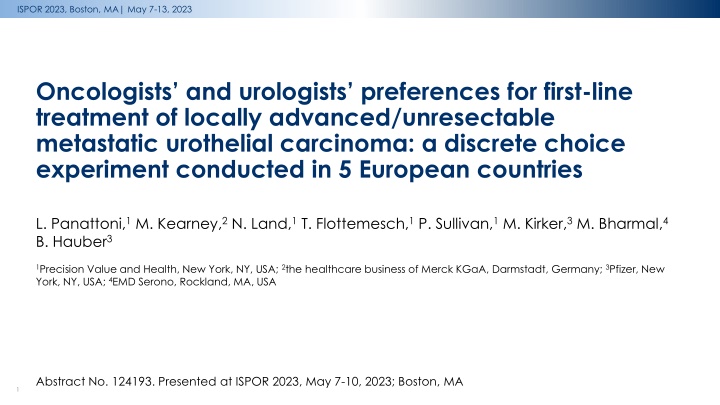
Preferences of Oncologists and Urologists for Urothelial Carcinoma Treatment: ISPOR 2023 Study
Explore the preferences of oncologists and urologists in 5 European countries for first-line treatment of urothelial carcinoma through a discrete choice experiment. The study aims to quantify treatment attributes, assess preferences across countries, and identify heterogeneity in physician preferences. Conducted at ISPOR 2023 in Boston, MA, the research sheds light on understanding treatment profiles and attributes for locally advanced or metastatic urothelial carcinoma.
Download Presentation

Please find below an Image/Link to download the presentation.
The content on the website is provided AS IS for your information and personal use only. It may not be sold, licensed, or shared on other websites without obtaining consent from the author. If you encounter any issues during the download, it is possible that the publisher has removed the file from their server.
You are allowed to download the files provided on this website for personal or commercial use, subject to the condition that they are used lawfully. All files are the property of their respective owners.
The content on the website is provided AS IS for your information and personal use only. It may not be sold, licensed, or shared on other websites without obtaining consent from the author.
E N D
Presentation Transcript
ISPOR 2023, Boston, MA| May 7-13, 2023 Oncologists and urologists preferences for first-line treatment of locally advanced/unresectable metastatic urothelial carcinoma: a discrete choice experiment conducted in 5 European countries L. Panattoni,1M. Kearney,2N. Land,1T. Flottemesch,1P. Sullivan,1M. Kirker,3M. Bharmal,4 B. Hauber3 1Precision Value and Health, New York, NY, USA; 2the healthcare business of Merck KGaA, Darmstadt, Germany; 3Pfizer, New York, NY, USA; 4EMD Serono, Rockland, MA, USA Abstract No. 124193. Presented at ISPOR 2023, May 7-10, 2023; Boston, MA 1
ISPOR 2023, Boston, MA| May 7-13, 2023 COI Disclosure Information Laura Panattoni is an employee of Precision Value and Health, which received funding from the sponsor to conduct this study. 2
ISPOR 2023, Boston, MA| May 7-13, 2023 Gaps in Knowledge of Preferences for Treatment Attributes and Profiles Among Physicians in Oncology A prior systematic literature review1 of preference studies in oncology found that physicians routinely rank the survival attribute of treatment as most important However, little is known about heterogeneity in physician preferences In different cancers and indications Across countries In trading off key attributes (eg, survival and adverse events) And how this impacts preferred treatment profiles Objective: to use the example of aUCto help inform our understanding of differences in physician preferences in the broader oncology space aUC, locally advanced or metastatic urothelial carcinoma. 1. Collacott H, et al. Patient. 2021;14(6):775-90. 3
ISPOR 2023, Boston, MA| May 7-13, 2023 Study Objectives To quantify preferences for attributes of 1L aUC treatments among oncologists and urologists in 5 European countries (Eu5; France, Germany, Italy, Spain, and the UK) 1 To assess oncologists and urologists preferences for different 1L treatment profiles across the 5 countries 2 To assess latent heterogeneity in oncologists and urologists preferences for treatment attributes and profiles 3 1L, first line; aUC, locally advanced or metastatic urothelial carcinoma. 4
ISPOR 2023, Boston, MA| May 7-13, 2023 Setting and Study Population Survey instrument Study population Sample size Oncologists and urologists who: Web-based survey incorporating a DCE 500 physicians (100 per country) Powered at 90% for full sample; 80% for country- level analysis2 Treat/manage 2 patients with aUC per month Administered August to September 2022 in Eu5 countries Adapted from a US study1 Asked about a typical 69-year- old male patient with aUC Have been practicing for 3 years Spend 50% of their time providing direct patient care aUC, locally advanced or metastatic urothelial carcinoma; DCE, discrete choice experiment. 1. Grivas P, et al. Future Oncol. Published online March 6, 2023. 2. Louviere JJ, Hensher DA, Swait JD. Stated Choice Methods: Analysis and Applications. Cambridge University Press; 2000. 5
ISPOR 2023, Boston, MA| May 7-13, 2023 DCE Question Example Treatment plan 1 Treatment plan 2 Treatment course 2 hypothetical treatment options 5 treatment attributes Likelihood of experiencing a grade 3/4 TRAE 75% grade 3/4 TRAEs 15% grade 3/4 TRAEs 90% grade 3/4 TRAEs 15% grade 3/4 TRAEs No treatment was not an option Duration of 1L treatment given Until progression Until progression 1 mo 2 mo 3 mo 4 mo 1 mo 2 mo 3 mo 4 mo Treatment 1 given for 4 mo followed by treatment 2 given until disease progression or unacceptable toxicity Treatment 1 given for 4 mo followed by treatment 2 given until disease progression or unacceptable toxicity Frequency of administration 2 wk 6 wk 2 wk 2 wk Once every 2 wk Once every 6 wk Once every 2 wk Once every 2 wk Time to progression, median Attribute levels varied according to a fractional factorial design1 5 mo 9 mo Overall survival, median 12 mo Each participant answered 12 questions 16 mo 1L, first line; DCE, discrete choice experiment; mo,month; TRAE, treatment- related adverse event; wk, week. 1. Jaynes J, et al. Stat Med. 2016;35(15):2543-60. Which treatment plan would you recommend? 6
ISPOR 2023, Boston, MA| May 7-13, 2023 Hypothetical 1L Treatment Profiles and Attribute Levels Treatment attributes calibrated from clinical trial data as of fall 2021 5 treatment attributes Induction frequency Progression- free survival Overall survival Maintenance frequency 4 hypothetical treatment profiles Grade 3/4 TRAE 75% 4 months no maintenance treatment Q1W None 5 months 12 months 1L chemotherapy only 15% until progression or unacceptable toxicity Q6W Q6W 6 months 16 months 1L ICI monotherapy 90% 4 months (ICI + chemotherapy) 15% (ICI) until progression or unacceptable toxicity 1L ICI combination therapy* (ICI + chemotherapy followed by ICI) Q1W Q6W 9 months 16 months 75% 4 months (chemotherapy) 15% (ICI) until progression or unacceptable toxicity 1L ICI maintenance therapy (chemotherapy followed by ICI) Q1W Q2W 9 months 24 months 1L, first line; ICI, immune checkpoint inhibitor; Q1W, once every week; Q2W, once every 2 weeks; Q6W, once every 6 weeks; TRAE, treatment-related adverse event. *Not approved in Europe. 7
ISPOR 2023, Boston, MA| May 7-13, 2023 Statistical Analysis and Outcome Measures Random parameters logit model Country-level results: single model with fixed effects country interaction terms Treatment attribute Preference weights RI 1 Estimated preference weights and treatment profiles (previous slide) Preference shares for the 4 treatment profiles 2 Latent class analysis1,2 to assess preference heterogeneity RI Preference shares 3 RI, relative importance. 1. Boeri M, et al. Pharmacoeconomics. 2020;38(6):593-606. 2. Weller BE, et al. J Black Psychol. 2020;46(4):287-311. 8
ISPOR 2023, Boston, MA| May 7-13, 2023 Physician Demographics and Practice Characteristics Full sample (n=498) Range across countries, % (country) p value Full sample Age, years Mean (SD) Sex, n (%) Female Male Prefer not to answer Primary specialty, n (%) Oncology Urology Years in practice, n (%) 3-10 11-18 >18 Practice setting, n (%) Public teaching hospital Public nonteaching hospital Private hospital Public or private office Specialist cancer center Average number of patients with aUC treated per month, n (%) 2-10 11-19 >20 0.266 45 (8) 44 (ES)-46 (DE) <0.001 69% were oncologists 110 (22) 359 (72) 29 (6) 13 (FR)-47 (ES) 48 (ES)-83 (FR) 3 (DE)-10 (UK) 69%had 10 years in practice <0.001 343 (69) 155 (31) 40% practiced in public teaching hospitals 54 (DE)-77 (IT) 23 (IT)-46 (DE) 0.038 154 (31) 259 (52) 85 (17) 21 (UK)-42 (IT) 42 (IT)-64 (UK) 14 (UK)-21 (DE) 45% treated 2-10 patients with aUC per month <0.001 200 (40) 121 (24) 101 (20) 53 (11) 23 (5) 24 (IT)-58 (ES) 19 (FR)-32 (IT) 7 (DE)-36 (FR) 0 (ES)-28 (DE) 2 (ES)-7 (DE) There were significant differences between countries for all characteristics except age <0.001 226 (45) 140 (28) 132 (27) 31 (FR)-55 (DE) 17 (ES)-49 (IT) 10 (IT)-39 (FR) DE, Germany; ES, Spain; FR, France; IT, Italy. 9
ISPOR 2023, Boston, MA| May 7-13, 2023 Preference Weights Across Treatment Attributes Full sample (n=498) 1.20 Physicians were more likely to choose a treatment associated with greater increases in overall survival (24 months) and a treatment course with greater reductions in TRAEs (R2) compared with the other attribute levels 1.01 0.80 0.49 0.40 0.09 0.09 0.01 0.01 0.00 0.02 0.03 0.09 0.03 0.05 0.03 0.01 0.07 0.38 0.40 Physicians placed relatively less importance on frequency of administration and changes in progression-free survival 0.80 0.98 1.20 R1 R2 R3 R4 1 wk 3 wk6 wk 2 wk 3 wk6 wk 5 mo 6 mo 9 mo 12 mo 16 mo 24 mo Overall survival Treatment Course/TRAEs* Induction frequency Maintenance frequency Progression- free survival *R1, 75% grade 3/4 TRAEs 4 months no treatment until progression. R2, 15% grade 3/4 TRAEs until progression. R3, 90% grade 3/4 TRAEs 4 months 15% grade 3/4 TRAEs until progression. R4, 75% grade 3/4 TRAEs 4 months 15% grade 3/4 TRAEs until progression. mo, month; TRAE, treatment-related adverse event; wk, week. 10
ISPOR 2023, Boston, MA| May 7-13, 2023 Relative Importance of Treatment Attributes* 1% Full 5% 62% 27% 4% sample (n=498) Overall survival had the strongest influence on physicians preferences (RI=62%) Country range: 52% (Germany)-64% (Spain, France) 3% 3% 2% Spain (n=101) 64% 27% 3% France (n=99) 64% 11% 11% 12% Treatment course/TRAEs was the second most influential attribute (RI=27%) Country range: 11% (France)-30% (UK) 3% Italy 59% 18% 8% 12% (n=100) 3% 4% UK 56% 30% 8% Induction and maintenance administration schedule and progression-free survival had less influence on preferences (combined RI=11%) (n=98) Germany (n=100) 52% 27% 7% 8% 6% 0% 20% 40% 60% 80% 100% Overall survival Treatment course/TRAE Progression-free survival Induction frequency Maintenance frequency RI, relative importance; TRAE, treatment-related adverse event. *Attribute RI (0-100%) is the difference in preference weights between the most preferred and least preferred level divided by the sum of the differences across all attributes. 11
ISPOR 2023, Boston, MA| May 7-13, 2023 Preference Shares for 1L Treatment Regimens A. Relative importance of treatment attributes B. Preference shares for 1L treatment regimens 1% Full 5% 62% 27% 4% 51% 12% 29% 9% sample (n=498) 3% 3% 2% Spain (n=101) 47% 13% 33% 7% 64% 27% 3% France (n=99) 56% 16% 20% 9% 64% 11% 11% 12% 3% Italy 38% 21% 26% 15% 59% 18% 8% 12% (n=100) 3% 4% UK 56% 32% 6% 56% 30% 8% 5% (n=98) 46% 10% 33% 11% Germany (n=100) 52% 27% 7% 8% 6% 0% 20% 40% 60% 80% 100% 0% 20% 40% 60% 80% 100% Overall survival Treatment course/TRAE Progression-free survival 1L ICI maintenance therapy 1L ICI monotherapy 1L ICI combination therapy 1L chemotherapy Induction frequency Maintenance frequency In the full sample, preference shares were the largest for the ICI maintenance therapy profile (51%) Country range: 38% (Italy)-56% (France, UK) 1L, first line; ICI, immune checkpoint inhibitor; TRAE, treatment-related adverse event. 12
ISPOR 2023, Boston, MA| May 7-13, 2023 Latent Class Results In a separate analysis (n=469), 4 latent classes were identified: Survival class (n=141; 30.1%) Overall survival was the dominant treatment attribute (RI=69%) Trade-off class (n=105; 22.4%) Treatment course/TRAEs(RI=57%) and overall survival(RI=33%) were both strongly important No strong preference class (n=192; 40.9%) A relatively balanced preference structure across attributes Aggressive treatment class (n=31; 6.6%) Treatment course/TRAEs was the dominant attribute (RI=88%), but there was a preference toward regimens with relatively higher TRAE attributes (R3, R4) A. Relative importance of treatment attributes 4% Survival class 5% 6% 69% 18% 2% 3% Trade-off class 33% 57% 5% No strong preference class 40% 20% 19% 11% 11% 2% 2% 3% Aggressive treatment class 88% 6% 0% 20% 40% 60% 80% 100% Overall survival Induction frequency Treatment course/TRAE Maintenance frequency Progression-free survival RI, relative importance; TRAE, treatment-related adverse event. 13
ISPOR 2023, Boston, MA| May 7-13, 2023 Latent Class Results A. Relative importance of treatment attributes B. Preference shares for 1L treatment regimens 4% 1% Survival class (n=141) 5% 6% 82% 13% 69% 18% 4% 2% 2% 3% Trade-off class (n=105) 33% 57% 98% 5% No strong preference class (n=192) 40% 20% 19% 11% 11% 19% 26% 25% 30% 2% 2% 2% 3% Aggressive treatment class (n=31) 88% 6% 12% 86% 0% 20% 40% 60% 80% 100% 0% 20% 40% 60% 80% 100% 1L ICI maintenance therapy 1L ICI monotherapy 1L ICI combination therapy 1L chemotherapy Overall survival Induction frequency Treatment course/TRAE Maintenance frequency Progression-free survival Preference shares varied significantly across latent classes, with the dominant treatment profile being ICI maintenance therapy in the survival class (82%), ICI monotherapy in the trade-off class (98%), and ICI combination therapy(86%) in the aggressive treatment class 1L, first line; ICI, immune checkpoint inhibitor; TRAE, treatment-related adverse event. 14
ISPOR 2023, Boston, MA| May 7-13, 2023 Results Summary and Limitations Overall survival was the dominant attribute driving treatment choice among physicians in the European region (RI=62%), followed by treatment course/TRAEs (RI=27%) Induction and maintenance frequency of administration and progression-free survival were less important treatment decision-making factors (combined RI=11%) Across countries, overall survival ranked as the most important attribute (RI range, 52% [Germany]-64% [Spain, France]) However, differences in the RI of attributes led to varying preference shares for the dominant therapy profile, 1L ICI maintenance therapy (range, 38% [Italy]-56% [France, UK]) Latent class analysis identified 4 different preference structures among physicians, each with a different dominant treatment profile In 2 preference groups (nearly 30% of physicians), overall survival was not the dominant attribute Limitation: the DCE asked physicians to consider a typical 69-year-old male patient with aUC; therefore, results may not be generalizable to all patients with aUC 1L, first line; aUC, locally advanced or metastatic urothelial carcinoma; DCE, discrete choice experiment; ICI, immune checkpoint inhibitor; RI, relative importance; TRAE, treatment-related adverse event. 15
ISPOR 2023, Boston, MA| May 7-13, 2023 Conclusions Our results in aUC were largely consistent with prior results in oncology1 Overall survival was the dominant attribute driving treatment choice, followed by treatment course/TRAEs;frequency of administration was least important While attribute rankings were similar across countries, differences in the RI of each attribute led to variations in the preference share for the dominant treatment profile Our results also show significant heterogeneity in preferences across 4 latent classes (which preferred different dominant treatment profiles) and that overall survival was not the dominant attribute for nearly 30% of physicians aUC, locally advanced or metastatic urothelial carcinoma; RI, relative importance; TRAE, treatment-related adverse event. 1. Collacott H, et al. Patient. 2021;14(6):775-90. 16
ISPOR 2023, Boston, MA| May 7-13, 2023 Acknowledgments This study was sponsored by the healthcare business of Merck KGaA, Darmstadt, Germany (CrossRef Funder ID: 10.13039/100009945), as part of an alliance between the healthcare business of Merck KGaA, Darmstadt, Germany and Pfizer. Correspondence: Laura Panattoni, Laura.Panattoni@precisionvh.com PRESENTATION PDF Copies of this presentation obtained through this Quick Response (QR) code are for personal use only and may not be reproduced without permission from ISPORand the author of this presentation. 17

